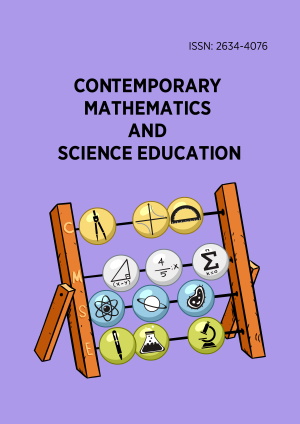Research Article
Teacher’s perception towards teaching and learning practice based on HOTs in mathematics
More Detail
1 Institute for Mathematical Research, Universiti Putra Malaysia, Serdang, Selangor, MALAYSIA2 Department of Human Science, Institute of Teacher Education Malaysia, Malay Language Campus, Lembah Pantai, Kuala Lumpur, MALAYSIA3 Faculty of Educational Studies, Universiti Putra Malaysia, Serdang, Selangor, MALAYSIA* Corresponding Author
Contemporary Mathematics and Science Education, 4(1), January 2023, ep23015, https://doi.org/10.30935/conmaths/13074
Submitted: 25 November 2022, Published: 14 March 2023
OPEN ACCESS 967 Views 788 Downloads
ABSTRACT
Teaching and learning practice based on higher thinking order skills (HOTs) in mathematics is a critical approach to developing thinking skills among teachers and students in the classroom. It will help increase students’ performance and encourage acceptance and attitude. This study aims to know the teacher simulation on getting student responses and their reactions; to know the using of non-routine questions, the impact of applying and implication to the student’s mind development; and to understand the acceptances and attitudes of the student. This study was conducted using a qualitative approach, which involved a survey with an open-end questionnaire. A total of 72 mathematics teachers were made up of different categories of schools. The findings indicate that teachers tend to question and encourage ideas to simulated students on getting their response. Students tend to reflect on the teacher’s simulation verbally as a reaction. Using non-routine questions, the finding showed that teachers who were applied in their teaching practice agreed that it affects the student’s mind development. Teachers are also aware that thinking motivation and experiencing will be the implication of using non-routine questions in mathematics lessons. It also helps to develop students’ performance levels. Other teachers are aware that adaptability, attracting, and self-expression appear most as acceptance and attitude of students during instruction. In conclusion, for effective teaching and learning practice based on HOTs in mathematics lessons, bringing the real-life problem to the discussion in class, encouraging student’s cognitive develop and engage to their behavior.
CITATION (APA)
Sulaiman, N., & Mohd Ayub, A. F. (2023). Teacher’s perception towards teaching and learning practice based on HOTs in mathematics. Contemporary Mathematics and Science Education, 4(1), ep23015. https://doi.org/10.30935/conmaths/13074
REFERENCES
- Anderson, L. W., & Krathwohl, D. R. (Eds.). (2001). A taxonomy for learning, teaching, and assessing: A revision of Bloom’s taxonomy of educational objectives. Addison Wesley Longman.
- Brookhart, S. M. (2010). How to assess higher-order thinking skills in your classroom. ASCD.
- Collins, R. (2014). Skills for the 21st century: Teaching higher-order thinking. Curriculum & Leadership Journal, 12, 10.
- KPM. (2012). Laporan awal pelan pembangunan pendidikan Malaysia 2013-2025 [Preliminary report of the Malaysian education development plan 2013-2025]. Kementerian Pendidikan Malaysia [Malaysia Education Ministry].
- Marzano, R. J. (2000). Designing a new taxonomy of educational objectives. Corwin Press.
- Marzano, R. J., & Pickering, D. J. (2006). Dimensions of learning teacher’s manual. ASCD.
- Murray, E. C. (2011). Implementing higher-order thinking in middle school mathematics classrooms [PhD thesis, The University of Georgia].
- Salih, M. (2014). Teacher’s perceptions and student’s motivation to thinking-based learning (TBL) in a classroom context. Journal Research, Policy & Practice of Teachers & Teacher Education, 4(2), 5-14.
- Swartz, R. J., & McGuinness, C. (2014). Developing and assessing thinking skills: The international baccalaureate project 2014 final report part 1: Literature review and evaluation framework. https://ibo.org/research/curriculum-research/cross-programme/developing-and-assessing-thinking-skills-2014/
- Swartz, R. J., Costa, A. L., Beyer, B. K., Reagan, R., & Kallick, B. (2010). Thinking-based learning: Promoting quality student achievement in the 21st century. Teachers College Press.
- Yunus, A. S. (2015). Developing students’ mathematical thinking: How far have we come? [Inaugural lecture]. Universiti Putra Malaysia.

 The articles published in this journal are licensed under the CC-BY Creative Commons Attribution International License.
The articles published in this journal are licensed under the CC-BY Creative Commons Attribution International License.